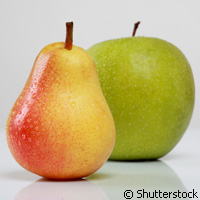White-fleshed fruits and veggies do the body good
The more fruits and vegetables you eat, especially white-fleshed goodies, the more you protect yourself against stroke, a new Dutch study shows. Presented in Stroke: Journal of the American Heart Association, the study was funded in part by the Europe Against Cancer Programme of the EU. It is common knowledge that eating fruits and vegetables helps cut the risk of stroke. Past studies have focused on preventive health benefits of fruits and vegetables, especially the food's nutritional value and characteristics including the plant's colour, edible part, botanical family and its capacity to provide antioxidants. But this latest study goes one step further by investigating the links between fruit and vegetable colours with stroke. The colour of the edible portion of fruits and vegetables reflects the presence of beneficial phytochemicals including carotenoids and flavonoids. Researchers from the Division of Human Nutrition at Wageningen University and the National Institute for Public Health and the Environment in the Netherlands investigated the association between fruit and vegetable colour group consumption with 10-year stroke incidence in a population-based study of 20,069 adults. The average age of the subjects was 41. None of the subjects suffered from cardiovascular diseases at the onset of the study, and completed a 178-item food frequency questionnaire for the previous year. The team classified fruits and vegetables in four colour groups: green (dark leafy vegetables, cabbages and lettuces); orange/yellow (citrus fruits); red/purple (red vegetables); and white (55% of which were apples and pears). The researchers documented 233 strokes over the decade-long follow-up period. No association was found between green, orange/yellow and red/purple fruits and stroke. They discovered a 52% drop in stroke risk for people who consumed a high number of white fruits and vegetables compared with peers who ate fewer amounts of the same fruits and vegetables. According to the team, each 25 gram per day increase in white fruit and vegetable consumption was linked to a 9% drop in the risk of stroke. The average apple is 120 grams. 'To prevent stroke, it may be useful to consume considerable amounts of white fruits and vegetables,' says lead author Linda M. Oude Griep, a postdoctoral fellow in human nutrition at Wageningen University. 'For example, eating one apple a day is an easy way to increase white fruits and vegetable intake. However, other fruits and vegetable colour groups may protect against other chronic diseases. Therefore, it remains of importance to consume a lot of fruits and vegetables.' Both apples and pears are high in dietary fibre and quercetin, which is a flavonoid widely distributed in nature. Other white-fleshed foods included in the study were bananas, cauliflower, chicory and cucumber. The study team classified potatoes as a starch. The researchers say that despite the results obtained in the study, more research is needed to substantiate the findings. Says Ms Oude Griep: 'It may be too early for physicians to advise patients to change their dietary habits based on these initial findings.' An accompanying editorial says the results should be interpreted with caution because food frequency questionnaires may not be reliable.For more information, please visit:Wageningen University:http://www.wur.nl/UK/Stroke: Journal of the American Heart Association:http://stroke.ahajournals.org/Europe Against Cancer Programme:http://ec.europa.eu/health/major_chronic_diseases/diseases/cancer/index_en.htm
Countries
Netherlands



